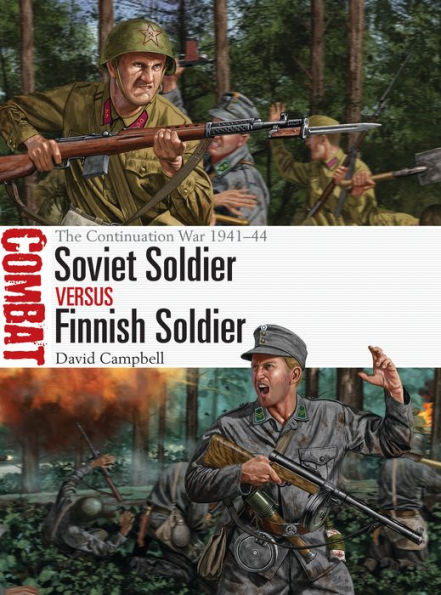In a bid to recapture territory conceded following the Winter War of 1939–40, Finnish forces cooperated with Nazi Germany and other Axis powers during the invasion of the Soviet Union in June 1941. Rapid Finnish progress in reoccupying lost ground in Karelia during the first few months of the invasion gave way to a more static form of warfare from October 1941. The Finns resisted German pressure to participate fully in the Axis attack on the beleaguered Soviet-held city of Leningrad, and the Continuation War came to be characterized by trench warfare and unconventional operations conducted by both sides behind the front lines. In June 1944 the stalemate was abruptly ended by a massive Soviet offensive that pushed the Finns back; the two sides clashed in a series of major battles, including the battle of Tali-Ihantala, with the Finns halting the Soviet advance before agreeing to an armistice that September.
The evolving military situation in this sector of the Eastern Front meant that the soldiers of the Soviet Union and Finland fought one another in a variety of challenging settings, prompting both sides to innovate as new technologies reached the front line. In this study, the doctrine, training, equipment and organization of both sides' fighting men are assessed and compared, followed by a detailed assessment of their combat records in three key battles of the Continuation War.
1132077385
The evolving military situation in this sector of the Eastern Front meant that the soldiers of the Soviet Union and Finland fought one another in a variety of challenging settings, prompting both sides to innovate as new technologies reached the front line. In this study, the doctrine, training, equipment and organization of both sides' fighting men are assessed and compared, followed by a detailed assessment of their combat records in three key battles of the Continuation War.
Soviet Soldier vs Finnish Soldier: The Continuation War 1941-44
In a bid to recapture territory conceded following the Winter War of 1939–40, Finnish forces cooperated with Nazi Germany and other Axis powers during the invasion of the Soviet Union in June 1941. Rapid Finnish progress in reoccupying lost ground in Karelia during the first few months of the invasion gave way to a more static form of warfare from October 1941. The Finns resisted German pressure to participate fully in the Axis attack on the beleaguered Soviet-held city of Leningrad, and the Continuation War came to be characterized by trench warfare and unconventional operations conducted by both sides behind the front lines. In June 1944 the stalemate was abruptly ended by a massive Soviet offensive that pushed the Finns back; the two sides clashed in a series of major battles, including the battle of Tali-Ihantala, with the Finns halting the Soviet advance before agreeing to an armistice that September.
The evolving military situation in this sector of the Eastern Front meant that the soldiers of the Soviet Union and Finland fought one another in a variety of challenging settings, prompting both sides to innovate as new technologies reached the front line. In this study, the doctrine, training, equipment and organization of both sides' fighting men are assessed and compared, followed by a detailed assessment of their combat records in three key battles of the Continuation War.
The evolving military situation in this sector of the Eastern Front meant that the soldiers of the Soviet Union and Finland fought one another in a variety of challenging settings, prompting both sides to innovate as new technologies reached the front line. In this study, the doctrine, training, equipment and organization of both sides' fighting men are assessed and compared, followed by a detailed assessment of their combat records in three key battles of the Continuation War.
17.6
In Stock
5
1

Soviet Soldier vs Finnish Soldier: The Continuation War 1941-44
80
Soviet Soldier vs Finnish Soldier: The Continuation War 1941-44
80Related collections and offers
17.6
In Stock

Product Details
| ISBN-13: | 9781472838315 |
|---|---|
| Publisher: | Bloomsbury Publishing |
| Publication date: | 08/20/2020 |
| Series: | Combat , #49 |
| Sold by: | Barnes & Noble |
| Format: | eBook |
| Pages: | 80 |
| File size: | 18 MB |
| Note: | This product may take a few minutes to download. |
About the Author
From the B&N Reads Blog
